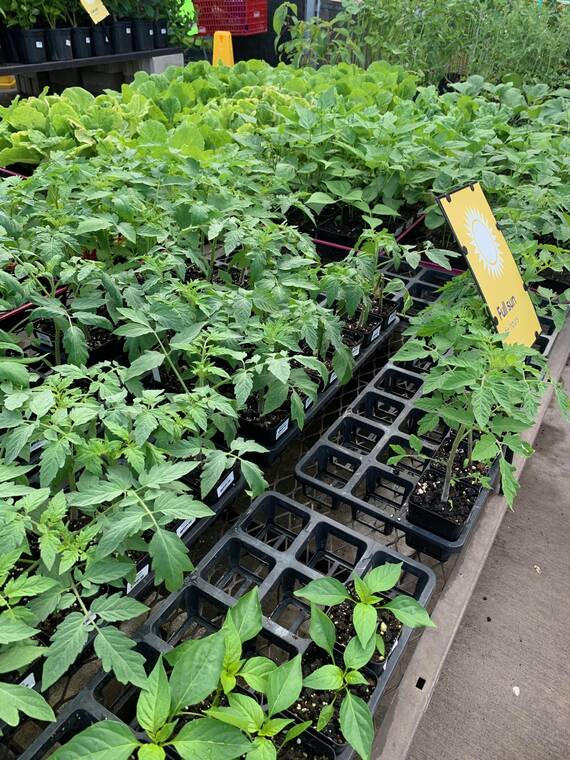Inflation and increasing food costs can be a problems but also an opportunity to be creative in your garden. One project to reduce food bills and have some family fun as is to grow your own vegetables. Yards and lanais are prime opportunity to help cut food expenses. You can do it by planting vegetables along with your ornamentals.
By designing a combination, you can have an attractive spot that will produce flowers as well as fresh vegetables. Both require regular fertilization and spraying for insects and disease, so they are a natural, together.
In selecting the location, remember that most annuals and vegetables must have a full six to eight hours of bright light per day.
Next comes the vexing problem of what to plant. Choosing plants by heights is one problem solving approach. Some taller vegetables to try are Hawaiian super sweet corn, trellis U.H tomatoes and Manoa wonder beans.
In the center rows and toward the front, consider the medium-height plants. Vegetables include peppers, squash and Waimanalo long eggplant. For low edging, you might try Waianae strain kai choi, won bok, Manoa lettuce and parsley that are good varieties of vegetables.
With scores of herbs and vegetables from which to choose, it shouldn’t be a problem to fill the garden with many kinds of colorful and useful plants.
You can try your hand at success by using the organic approach or the conventional approach or a combination.
Organic gardening differs from conventional gardening mainly in fertilization and pest control. The organic gardener uses natural and organic materials and methods, whereas the conventional gardener will utilize a combination of all materials and methods shown to be safe, effective and nondetrimental to animals and the environment.
Here are some steps to aid you in supplying your vegetable needs.
Select a spot of well-drained soil near a water supply. It should be close to the home for convenience but should not be shaded by tall buildings or trees. Enclosing the garden spot with a fence is important if you need to keep out wild jungle fowl, pheasants and pigs.
Many gardeners find it helpful to draw out on paper the location of each row and the crop or succession of crops to be planted.
Under normal circumstances, you may contact the UH Master Gardener Hotline for information about vegetables suited to Hawaiian gardens, leading varieties, seed or plants needed, planting distances and depths, and best type for planting now.
An advantage for using organic materials as fertilizers is that they contain many of the elements also needed by the plants in addition to nitrogen, phosphorus and potassium. Besides the general amounts of minor elements found in most organic materials, certain ones are concentrated into such naturally occurring materials as gypsum (calcium and sulfur) and dolomite (calcium and magnesium). Important minor elements include iron, zinc, manganese and boron. However care must be taken not to over apply, especially boron since it can be toxic.
Reducing the acidity of the soil is the primary purpose for using lime in the garden. However, liming materials also provide nutrients for plant use.
Calcium and magnesium are the two most elements most commonly provided by dolomitic lime. Lime to sweeten the soil should be applied only when the needs have been established by a reliable soil test. Apply lime in advance of the planting date. Mix well with the soil and keep moist.
In irrigating the garden, it is advisable to thoroughly wet the soil once a week unless sufficient rain falls. Thus, the soil will be moistened throughout the root zone. Light sprinkling everyday merely tends to wet the surface and encourage shallow root growth. Use of organic materials as soil conditioners and fertilizers tends to improve the ability of the soil to retain moisture.
Garden mulch will conserve soil moisture. Mulch is any material, usually organic, that is placed on the soil surface around the plants. Organic materials most commonly used for mulching are leaves, grass clippings, sawdust and wood shavings. Mulches should not be piled up against the stems of plants since this will create conditions ideal for disease.
Synthetic materials, such as plastic sheeting, have been used in recent years. Among the benefits of a mulch are that it conserves soil moisture, conserves nutrients, reduces soil erosion, reduces weed growth and provides barrier between fruit and soil. It also moderates the soil temperature.
During periods when infestations of various garden pests are high, control by natural means becomes very difficult. However, the following practices will help to reduce losses.
Plant varieties resistant to disease and insects. Select pest-free transplants that may be purchased at local garden shops. Keep out weeds that harbor insects and diseases. Hand remove insects where possible.
Water in morning so that plants are not wet at night.
Dispose of severely diseased plants before they contaminate others. Planting marigolds tend to repel nematodes.
Many organic gardeners approve of and use sprays and other preparations containing naturally occurring materials. Neem, pyrethrin and nicotine are examples of natural poisons from plant parts. These give some control to some insects under certain conditions. Natural predators like lizards, frogs, praying mantis and lady beetles should be encouraged wherever possible.
Suitable materials for growing vegetables the organic way are not always easy to locate. Garden supply stores carry many products, especially seeds and equipment that may be used by the organic enthusiast.
For further information about vegetable gardening, call the UH College of Tropical Agriculture Master gardener helpline. For East Hawaii you may call (808) 981-5199 or in West Hawaii (808) 322-4893. Several vegetable gardening books are also available at local garden shops.
Norman Bezona is professor emeritus, University of Hawaii College of Tropical Agriculture and Human Resources.

